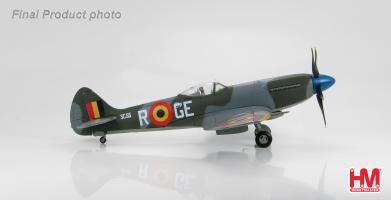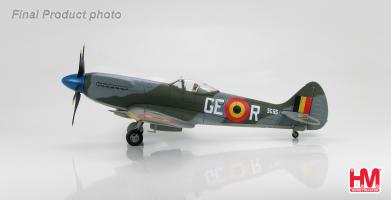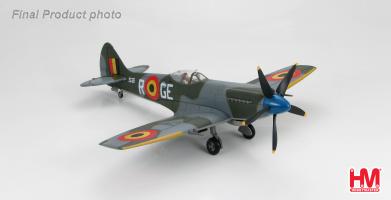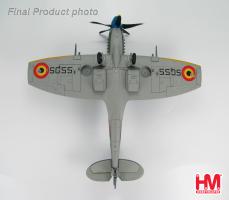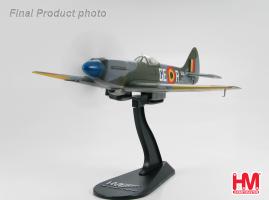Hobby Master Archive
Air Power Propellers 1/48
Spitfire
Spitfire F.XIV SG55, 349th Sqn., Belgian Air Force
Hobby Master 1/48 Air Power Series HA7113 Spitfire F.XIV SG55, 349th Sqn., Belgian Air Force
1/48 scale pre-finished Die-cast metal with a minimum of plastic. Professionally painted. All markings pad applied for superb results. Cockpit slides open. Cockpit side door opens. Comes with a pilot that can be removed. Comes with display stand. Landing gear is fully retractable and can be displayed up or down. Removable wing gun covers. Propeller is metal. Extremely sought after by collectors.
Spitfire XIV specifications Basic information: Country of origin: Britain Classification: single-engine fighter Crew: 1 Production: first produced in 1943 Number produced: 957 of all XIV variants Dimensions: Wingspan: 36ft 10in (11.23m) Length: 32ft 8in (9.96m)
Performance: Powerplant: 1 X Rolls-Royce Griffon 65 12 cylinder liquid-cooled engine 2,035hp (1,517kW) Speed max: 447mph (720km/h) Range: 460 miles (740 km) on internal tanks Ceiling max: 42,978ft (13,100m)
Weight: Empty: 6,603lb (2,995kg) Maximum: 10,285lb (4,665kg)
Armament: 2 X 20mm (.078in) Hispano cannons 4 X Browning 7.7mm (0.303in) machine guns Up to a 1,000lb (454kg) payload with other options possible
Probably one of the best-known fighters of WWII the Spitfire had a big psychological effect at home and in Germany. With its great performance the British were given hope of surviving the Battle of Britain and the German pilots learned to respect its fighting capabilities. The name Spitfire came from a nickname the director of Vickers-Armstrongs had for his spirited daughter. There were 24 marks of the Spitfire and many sub-variants. The Mk. XIV was only an interim variant until the Mk. XVIII could be produced. The Spitfire was the only Allied aircraft in continuous production throughout WWII with 957 Mk. XIVs being produced. The Mk. XIV received several modifications such as a bubble canopy and a modified rear fuselage.
In July 1942 Spitfire F.XIV that would eventually become MV246 c/n 6S/64170 was ordered by the RAF from Vickers-Armstrong. The aircraft wasn’t delivered until 1944 and arrived at No. 9 Maintenance Unit, RAF Cosford on November 29, 1944. MV246 never saw service with the RAF and was sold to the Belgian Air Force as SG-55 arriving in Belgium on September 1, 1948. The aircraft was assigned to the 349th Squadron and coded GE-R. Unfortunately on October 11, 1948 during a flight the engine quit and the pilot was forced to make a belly-landing. The battered aircraft was stored until February 25, 1951 when it became the property of the Musee Royale de l’Armee et d’Histoire Militaire. It wasn’t until 1977 that restoration of GE-R began using parts from RM860 (SG37) and RM623 (SG46). The project was finally completed in 1996 and GE-R is on display at the Musee Royale de l’Armee et d’Histoire Militaire (Royal Museum of the Army and Military History)., Jubelpark, Brussels, Belgium.
| Added to archive | 2015-11-19 |
| Last modified | 2015-11-19 |
| Leaflet | 2012-07-01 July 2012 |
